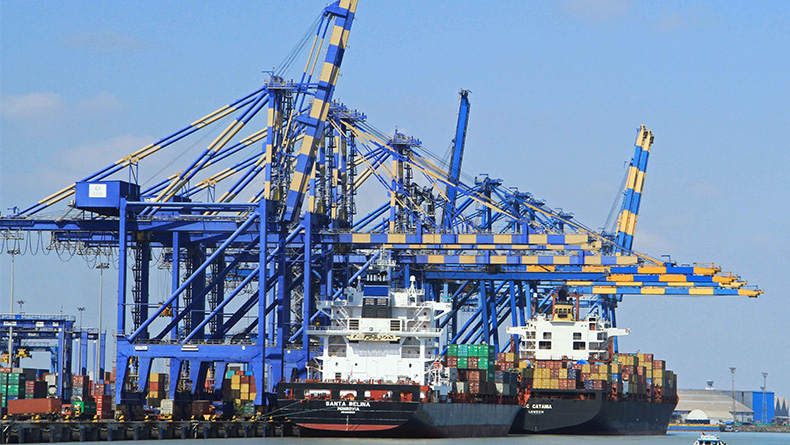As The Value Of Rupee Falls, Adani Ports’ Gross Debt Widens To $45,534 Crores
Gross debt as of December 2022 was Rs 45,534 crore compared to Rs 45,453 crore in March 2022. The company said long-term debt was Rs 43,164 crore, while short-term debt was Rs 2,370 crore till December 2022.

As the value of the rupee falls, the gross debt of Adani Ports and Special Economic Zone Ltd. increased by Rs 81 crore as the port operator suffered foreign exchange losses. Gross debt as of December 2022 was Rs 45,534 crore compared to Rs 45,453 crore in March 2022. The company said long-term debt was Rs 43,164 crore, while short-term debt was Rs 2,370 crore till December 2022. Meanwhile, the value of the foreign exchange market stood at Rs 2,744 crore. This includes a foreign exchange loss of Rs 1,886 crore, according to the filing.
If we talk about Adani Ports Q3 FY23 highlights, then the points to note are-
- Consolidated net profit decreased by 16.4%. Profit fell from Rs 1567.01 crore to Rs 1315.54 crore in December 2022 compared to last year.
- EBITDA, which was estimated at Rs 2,927.8 crore, grew by 4% to Rs 2,707.5 crore
Several factors, including the ongoing Ukraine crisis, interest rate hikes by the US central bank, and investors selling Indian stocks to buy foreign ones, are seen as the factors affecting the Indian currency.
Financial experts say that as inflation rises globally and domestic growth slows, investors typically look to sell their Indian assets and put money into US markets for better safety and returns. Indian currency is depreciating against the dollar mainly due to a widening trade deficit, with imports growing much faster than exports, they added.

According to the federal Ministry of Commerce and Industry, India’s merchandise exports stood at US$192.59 billion in April-August, and merchandise imports stood at US$317.81 billion during the same period. A weaker rupee makes imports more expensive and thus has a short-term negative impact on domestic production and GDP as a whole.
The growth in imports is due to the sharp rise in oil prices after the Ukrainian crisis. The increase in the import bill for coal and other basic commodities, especially raw materials, inflated the import bill.
Impact Of Falling Rupee
The weakening of the Indian currency against the dollar will have an impact on the Indian economy and common citizens. A fall in the Indian currency means a depreciation of its value against the US dollar, which generally means that the government, c, companies, and citizens are forced to pay more and more money. Currency depreciation is a direct indicator of inflation.
As the value of the Indian rupee falls, imports of goods and raw materials become more and more expensive, which then pushes up prices in the domestic market. India is the world’s third-largest oil consumer and imports more than 80 percent of its oil from other countries to meet its needs. A weakening rupee puts pressure on already high import prices of oil and raw materials, resulting in higher imported inflation. As fuel prices rise, so do the prices of almost all other goods and products sold in India.
If oil prices continue to rise, there is a possibility that the decline in the Indian currency will continue. Inflation in the country would thus continue to rise. On the other hand, a stronger dollar means you need more Indian currency to buy it than before. The personal finances of Indians are directly and indirectly affected by the falling Indian currency.

Since India is largely an import-dependent country, the consequences of a weak Indian currency are more severe. Imported goods become more expensive, hence the weakening of the rupee is one of the factors currently contributing to rising inflation. Prices of household goods are also expected to rise.
Importing Industries That Feel The Heat
In the given scenario, industries where imports are a critical component in manufacturing segments are likely to feel the heat. Industrial production costs are likely to rise in automotive, electronics, hardware, and other segments where import dependence is high.
With a falling rupee, imports will become more expensive while exports will be competitive. Regardless of what is imported, the prices of most commodities are tied to international prices. The value of any currency goes down or up based on the demand for one currency over another. The demand for currency is driven by total national imports and exports. Just as when India imports more than it exports, it will increase the demand for the surplus US dollar.
- Whenever oil prices see a price hike, India’s total oil import expenditure increases against its exports. In the last 3-4 months, oil has seen a huge price increase due to the Russo-Ukrainian war.
- From the start of the 2022-23 fiscal year to date, foreign investors have sold shares worth more than US$28.4 billion. This foreign fund outflow figure is even higher than the US$11.8 billion during the 2008 global financial crisis.
- Other reasons for the decline in the value of the Indian rupee are unemployment, economic problems, and higher inflation rates.
Effect of the falling Indian rupee on the Indian economy
The fall of the rupee is having a bad impact on the economy as the country’s inflation rate is rising. However, the depreciation of the currency improves the country’s exports as it becomes cheaper for foreign buyers, but under the current scenario, there is a huge reduction in overall global demand. Thus, overall exports from the nation also decreased, further contributing to the fall of the Indian rupee. With the fall of the Indian rupee, the SME sector is severely affected, resulting in job losses and increased unemployment.

Consequences of falling rupee
- Higher exports
When the rupee depreciates, it may be easier for Indian export-oriented companies to compete because their products will be cheaper for foreign buyers.
- Discourages imports and encourages domestic industry
When the rupee falls, India’s import costs go up. Indian companies compete with multinational companies, and it could be easier for such Indian companies to compete with MNCs as import costs rise.
- Chances of improving the trade balance
If the domestic industry can take advantage of the falling rupee and produce goods that can more closely replace imports and exports, India’s trade balance could improve.
- Your investments in foreign markets can become more attractive
The value of your expected profits from investments in foreign markets may increase. As the rupee depreciates, the returns you earn in foreign currencies will have a higher rupee value.
The negative impact of rupee depreciation
Some of the negative effects of the falling Indian Rupee are:
- Higher import costs
When the rupee falls, imports will become more expensive. If Indian companies can provide cheaper alternatives to imported products, Indian imports will decrease and the trade balance may improve. However, if Indian companies are unable to take advantage of the depreciation of the rupee, India’s import costs will increase.
If the domestic industry fails to take advantage of the fall in the rupee and foreign investors pull out of Indian assets, this may lead to further depreciation of the Indian rupee. Higher import costs and capital outflows would increase the supply of the Indian rupee as well as the demand for foreign currencies.

How does capital outflow affect the Indian rupee?
A devaluation of the Indian rupee would reduce the expected returns of foreign investors. This may lead to further capital outflows. Capital outflows and currency depreciation can thus form a cycle.
The US dollar is considered a safe currency. A safe-haven currency is usually expected not to lose value during times of market volatility. In 2022, the risks of recession in economies around the world spooked investors, leading to higher demand for US dollars. A rise in interest rates by the US central bank could direct capital to US bond markets. The Indian rupee thus weakened against the US dollar.
Edited by Prakriti Arora




